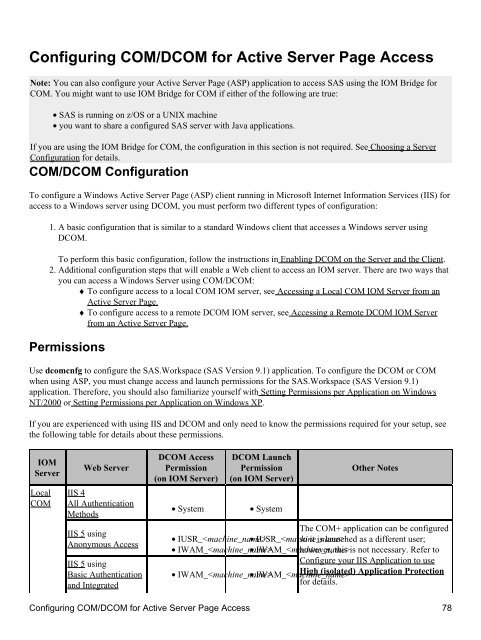SAS® Integration Technologies: Administrator's Guide (LDAP Version)
SAS® Integration Technologies: Administrator's Guide (LDAP Version)
SAS® Integration Technologies: Administrator's Guide (LDAP Version)
You also want an ePaper? Increase the reach of your titles
YUMPU automatically turns print PDFs into web optimized ePapers that Google loves.
Configuring COM/DCOM for Active Server Page Access<br />
Note: You can also configure your Active Server Page (ASP) application to access SAS using the IOM Bridge for<br />
COM. You might want to use IOM Bridge for COM if either of the following are true:<br />
• SAS is running on z/OS or a UNIX machine<br />
• you want to share a configured SAS server with Java applications.<br />
If you are using the IOM Bridge for COM, the configuration in this section is not required. See Choosing a Server<br />
Configuration for details.<br />
COM/DCOM Configuration<br />
To configure a Windows Active Server Page (ASP) client running in Microsoft Internet Information Services (IIS) for<br />
access to a Windows server using DCOM, you must perform two different types of configuration:<br />
1.<br />
A basic configuration that is similar to a standard Windows client that accesses a Windows server using<br />
DCOM.<br />
To perform this basic configuration, follow the instructions in Enabling DCOM on the Server and the Client.<br />
2. Additional configuration steps that will enable a Web client to access an IOM server. There are two ways that<br />
you can access a Windows Server using COM/DCOM:<br />
♦ To configure access to a local COM IOM server, see Accessing a Local COM IOM Server from an<br />
Active Server Page.<br />
♦ To configure access to a remote DCOM IOM server, see Accessing a Remote DCOM IOM Server<br />
from an Active Server Page.<br />
Permissions<br />
Use dcomcnfg to configure the SAS.Workspace (SAS <strong>Version</strong> 9.1) application. To configure the DCOM or COM<br />
when using ASP, you must change access and launch permissions for the SAS.Workspace (SAS <strong>Version</strong> 9.1)<br />
application. Therefore, you should also familiarize yourself with Setting Permissions per Application on Windows<br />
NT/2000 or Setting Permissions per Application on Windows XP.<br />
If you are experienced with using IIS and DCOM and only need to know the permissions required for your setup, see<br />
the following table for details about these permissions.<br />
IOM<br />
Server<br />
Local<br />
COM<br />
Web Server<br />
IIS 4<br />
All Authentication<br />
Methods<br />
IIS 5 using<br />
Anonymous Access<br />
IIS 5 using<br />
Basic Authentication<br />
and Integrated<br />
DCOM Access<br />
Permission<br />
(on IOM Server)<br />
DCOM Launch<br />
Permission<br />
(on IOM Server)<br />
• System<br />
• System<br />
Other Notes<br />
The COM+ application can be configured<br />
• IUSR_ • IUSR_<br />
so it is launched as a different user;<br />
• IWAM_ • IWAM_<br />
however, this is not necessary. Refer to<br />
Configure your IIS Application to use<br />
• IWAM_ • IWAM_<br />
High (isolated) Application Protection<br />
for details.<br />
Configuring COM/DCOM for Active Server Page Access 78
















